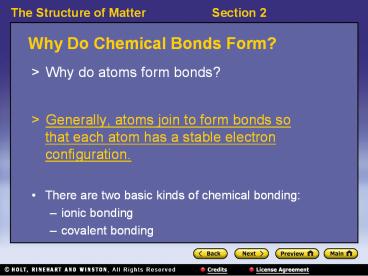Why Do Chemical Bonds Form? PowerPoint PPT Presentation
Title: Why Do Chemical Bonds Form?
1
Why Do Chemical Bonds Form?
- Why do atoms form bonds?
- Generally, atoms join to form bonds so that each
atom has a stable electron configuration. - There are two basic kinds of chemical bonding
- ionic bonding
- covalent bonding
2
Comparing Ionic and Covalent Bonds
3
Ionic Bonds
- How do ionic bonds form?
- Ionic bonds form from the attractions between
oppositely charged ions. - ionic bonds the attractive force between
oppositely charged ions, which form when
electrons are transferred from one atom to another
4
Ionic Bonds, continued
- Ionic bonds are formed by the transfer of
electrons. - Two atoms tend to form an ionic bond when one
atom has more attraction for electrons than the
other.
5
Covalent Bonds
- What do atoms joined by covalent bonds share?
- Atoms joined by covalent bonds share electrons.
- covalent bond a bond formed when atoms share one
or more pairs of electrons. - Compounds that are networks of bonded atoms, such
as silicon dioxide, are also covalently bonded. - Covalent bonds usually form between nonmetal
atoms.
6
Covalent Bonds, continued
- Atoms do not always share electrons equally.
- nonpolar covalent bonds bonds in which electrons
are shared equally - When two atoms of different elements share
electrons, the electrons are not shared equally. - polar covalent bond a bond in which there is an
unequal sharing of electrons. - Electrons tend to be more attracted to atoms of
elements that are located farther to the right
and closer to the top of the periodic table.
7
Metallic Bonds
- What gives metals their distinctive properties?
- Metals are flexible and conduct electric current
well because their atoms and electrons can move
freely throughout a metals packed structure. - metallic bond a bond formed by the attraction
between positively charged metal ions and the
electrons around them
8
Polyatomic Ions
- How are polyatomic ions similar to other ions?
- A polyatomic ion acts as a single unit in a
compound, just as ions that consist of a single
atom do. - polyatomic ion an ion made of two or more atoms
PowerShow.com is a leading presentation sharing website. It has millions of presentations already uploaded and available with 1,000s more being uploaded by its users every day. Whatever your area of interest, here you’ll be able to find and view presentations you’ll love and possibly download. And, best of all, it is completely free and easy to use.
You might even have a presentation you’d like to share with others. If so, just upload it to PowerShow.com. We’ll convert it to an HTML5 slideshow that includes all the media types you’ve already added: audio, video, music, pictures, animations and transition effects. Then you can share it with your target audience as well as PowerShow.com’s millions of monthly visitors. And, again, it’s all free.
About the Developers
PowerShow.com is brought to you by CrystalGraphics, the award-winning developer and market-leading publisher of rich-media enhancement products for presentations. Our product offerings include millions of PowerPoint templates, diagrams, animated 3D characters and more.

